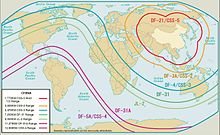| DF-31 (CSS-10) | |
|---|---|
 DF-31 in Military Museum of the Chinese People's Revolution | |
| Type | Intercontinental ballistic missile |
| Place of origin | People's Republic of China |
| Service history | |
| In service | 2006 (DF-31), 2007 (DF-31A), 2017 (DF-31B) |
| Used by | People's Liberation Army Rocket Force |
| Production history | |
| Manufacturer | Academy of Rocket Motors Technology (ARMT) |
| Specifications | |
| Mass | 54 t (54,000 kg; 60 short tons) |
| Length | 21.6 m (70 ft 10 in) |
| Diameter | 2.37 m (7 ft 9 in) |
| Warhead | 1 x 1 Mt or 5 x 90kt[1] |
| Engine | Solid-fuel rocket |
Operational range | 7,200–8,000 km (4,500–5,000 mi) (DF-31)[2][3] 13,200 km (8,200 mi) (DF-31A)[3] |
| Flight altitude | up to 1200 km |
| Maximum speed | Up to 8.16 km/s |
Guidance system | Astro-inertial guidance with BeiDou Navigation Satellite System |
| Accuracy | 100 m CEP for silo launched and 150 m for TEL-launched.[4] |
Launch platform | Silo, 8 axle TEL |


The Dong Feng 31 (simplified Chinese: 东风-31; traditional Chinese: 東風-31; lit. 'East Wind-31'; NATO reporting name CSS-10)[5] is a third-generation long-range, road-mobile, three stage, solid-fuel rocket intercontinental ballistic missile (ICBM) in the Dongfeng missile series developed by the People's Republic of China. It is designed to carry a single 1-megaton thermonuclear weapon. It is a land-based variant of the submarine-launched JL-2. It is operated by the People's Liberation Army Rocket Force (PLARF). In 2009, the Chinese inventory was estimated as under 15 DF-31 missiles and under 15 DF-31A missiles.[6] US Air Force National Air and Space Intelligence Center estimates that as of June 2017, five to ten Mod 1 and over fifteen Mod 2 launchers were operationally deployed.[7]
- ^ "Archived copy" (PDF). Archived from the original (PDF) on 2016-03-04. Retrieved 2015-09-06.
{{cite web}}: CS1 maint: archived copy as title (link) - ^ CSS-10 (DF-31), missilethreat.csis.org
- ^ a b Annual Report to Congress: Military Power of the People's Republic of China 2008, Office of the Secretary of Defense
- ^ "Dong Feng 31 (DF-31/DF-31A/CSS-10)". Missile Threat.
- ^ https://www.nasic.af.mil/LinkClick.aspx?fileticket=F2VLcKSmCTE%3D&portalid=19 [bare URL PDF]
- ^ Cite error: The named reference
NASICwas invoked but never defined (see the help page). - ^ http://www.nasic.af.mil/LinkClick.aspx?fileticket=F2VLcKSmCTE%3d&portalid=19 [bare URL PDF]